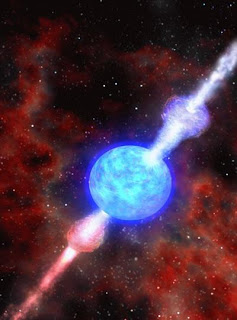What is a star?
A star is a massive, luminous ball of plasma that is held together by gravity. The nearest star to Earth is the Sun, which is the source of most of the energy on Earth. Other stars are visible in the night sky, when they are not outshone by the Sun. Historically, the most prominent stars on the celestial sphere were grouped together into constellations, and the brightest stars gained proper names.
For most of its life, a star shines due to thermonuclear fusion in its core releasing energy that traverses the star's interior and then radiates into outer space. Almost all elements heavier than hydrogen and helium were created by fusion processes in stars.
The total mass of a star is the principal determinant in its evolution and eventual fate. Other characteristics of a star are determined by its evolutionary history, including the diameter, rotation, movement and temperature. A plot of the temperature of many stars against their luminosities, known as a Hertzsprung-Russell diagram (H–R diagram), allows the age and evolutionary state of a star to be determined.
How a star is formed?
The formation of a star begins with a gravitational instability inside a molecular cloud, often triggered by shock waves from supernovae (massive stellar explosions) or the collision of two galaxies (as in a starburst galaxy). Once a region reaches a sufficient density and it begins to collapse under its own gravitational force.
Diameter
Due to their great distance from the Earth, all stars except the Sun appear to the human eye as shining points in the night sky that twinkle because of the effect of the Earth's atmosphere. The Sun is also a star, but it is close enough to the Earth to appear as a disk instead, and to provide daylight. Other than the Sun, the star with the largest apparent size is R Doradus, with an angular diameter of only 0.057 arcseconds.
The disks of most stars are much too small in angular size to be observed with current ground-based optical telescopes, and so interferometer telescopes are required in order to produce images of these objects. Another technique for measuring the angular size of stars is through occultation. By precisely measuring the drop in brightness of a star as it is occulted by the Moon (or the rise in brightness when it reappears), the star's angular diameter can be computed.
Stars range in size from neutron stars, which vary anywhere from 20 to 40 km in diameter, to supergiants like Betelgeuse in the Orion constellation, which has a diameter approximately 650 times larger than the Sun about 0.9 billion kilometres. However, Betelgeuse has a much lower density than the Sun.




No comments:
Post a Comment